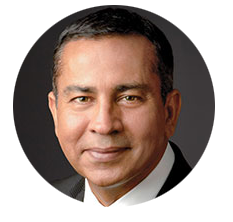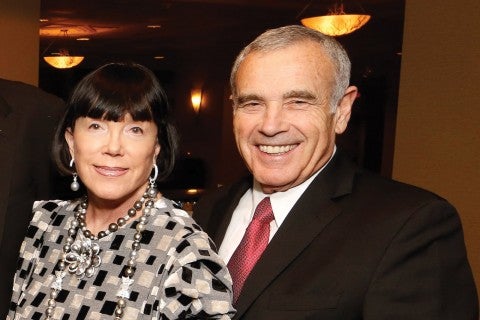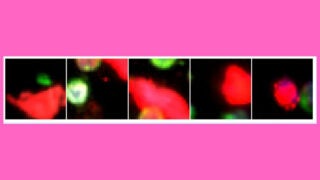
A Bold Vision Comes Into Focus at USC Roski Eye Institute
The institute will change how we see the world—and the ways we can live better in it.
Vivian Hoorn was scared. She knew that something wasn’t right with her vision. Grey polka dots kept dancing across the pages of her favorite books as she tried to read them.

In the back of her mind was one thought: her father. She had watched as he slowly went blind just as he was retiring, and he wasn’t able to enjoy his leisure years. So Hoorn turned to Keck Medicine of USC professor and ophthalmologist Rohit Varma.
Hoorn, who is now 69 and a retired elementary school principal, still remembers hearing his startling diagnosis: She had lost half her vision to glaucoma.
But Varma also promised to take care of her. Today, 14 years after that first appointment, Hoorn’s sight remains steady, thanks to prescription eye drops and specialized follow-up testing twice a year.
“It’s not an easy thing, living with fear every day of your life,” Hoorn says. “Now, that fear is removed.”
Besides using her medication, Hoorn also takes part in a USC study to track the prevalence and development of glaucoma in Latinos, which gives her access to the best technology available to track visual deterioration.
By 2050, 16.4 million Americans over age 40 will have impaired vision—more than double the number today. More than 2 million people over age 40 will be blind.
For physicians and researchers at the USC Roski Eye Institute, understanding who is at greatest risk for vision problems is just as important as why and how these problems develop. The institute, which Varma leads, studies blindness and eye problems across our nation’s population, in addition to developing technology and expertise to treat patients.
That’s especially important because in the coming decades, the number of Americans with eye disease and impairment issues like age-related macular degeneration, glaucoma, diabetic retinopathy and cataracts will dramatically increase. By 2050, 16.4 million Americans older than 40 will have impaired vision—more than double the number today, according to a study by Varma and other USC Roski Eye Institute researchers published in the Journal of the American Medical Association (JAMA) Ophthalmology. In addition, more than 2 million people over age 40 will be blind.
USC Roski Eye Institute doctors see a chance to make a dent in those numbers and help the people they represent.
Predicting the Burden
Vision loss affects people and societies in ways far beyond just visual perception. People with impaired vision can suffer both physical and mental health decline, including an increased risk for chronic health conditions, explains Varma, holder of the Grace and Emery Beardsley Chair in Ophthalmology. “Many people become depressed and unstable, and those are all aspects we want to understand so we can treat the person as a whole and not just the eye,” he says. “Whatever we do in the way of treatment, we want to see positive improvement in the life of a person, in addition to improvement in vision.”
The aging of baby boomers is expected to bring a wave of age-related eye diseases like glaucoma, cataracts, dry eye and age-related macular degeneration—a deterioration of the retina that’s the leading cause of vision loss in the elderly. With more people living with diabetes, as well, more will have eye-related complications from the disease.
The results of the JAMA study showed that vision loss will hit some of us disproportionately hard. The largest group of people expected to have impaired vision is non-Latina white women older than 60. That’s partly because women live longer than men, so they’ll lead the way through sheer numbers. But various ethnic groups, from people of Chinese descent to African-Americans, will face their own health challenges.
Treatments on the Horizon
USC Roski Eye Institute researchers look to treat some of the most prevalent—and tricky—eye problems. Take dry eye, for one. It affects 25 million to 30 million people in the U.S. alone. Whether it’s itching, pain, burning, blurred vision or light sensitivity, dry eye’s symptoms can hurt quality of life, says Shinwu Jeong, assistant professor of research ophthalmology at USC Roski Eye Institute. Post-menopausal women are especially prone to it.
Jeong’s research shows promise, though. He and fellow researchers found that a natural protein in tears, called clusterin, might be used to treat dry eye syndrome. In the lab, they found that clusterin seals and protect the eye by binding to its surface. They are now investigating using clusterin as a biotherapeutic for dry eye and also plan to expand its applicability to treat other indications like wound healing, Jeong says.
His fellow USC Roski Eye Institute researcher Sarah Hamm-Alvarez works on dry eye in a particular type of patient: people with Sjögren’s syndrome, an autoimmune disease that affects about 4 million Americans. The syndrome attacks glands that produce tears and saliva, compromising a person’s quality of vision. Hamm-Alvarez explores the molecular process involved in disease development and uses nanotechnology to efficiently target treatment sites inside the eye. She also develops new tests to rapidly diagnose patients based on changes in their tear composition so they can get targeted treatment faster.

A Vision to Help Others
The USC Roski Eye Institute pioneers research and treatment for visual impairments.
Her research also looks at new ways of delivering drugs, including formulations that make drugs stay on the eye’s surface more readily and drugs that are released over time from contact lenses or injections. Getting drugs to the right part of the eye is a part of her research as well, since the gland that produces tears isn’t in the front of the eye. These pre-clinical studies are still in early phases, but Hamm-Alvarez hopes the treatments will reach patients in the next few years.
Newer Treatments for Older Eyes
Patients who have macular degeneration have few treatment options today, but stem cells might become one.
Age-related macular degeneration, also known as AMD, is a progressive disease that affects part of the retina, called the macula, which enables people to read, see faces and drive. More than 2 million people in the United States suffer from AMD. It’s not only common, but it’s also extremely frustrating: The vision loss associated with AMD is in the central part of a person’s field of vision. The disease comes in two forms: wet and dry. Patients with the dry type have no treatments available—yet.
An early-stage $19 million USC-based clinical study, currently recruiting patients, will use embryonic stem cells to produce retina pigment epithelium cells, which would replace macula cells lost in AMD. These cells are located in a thin sheet at the back of the eye, so researchers have learned how to grow them as a thin layer of single cells, just the way they are found in the human body. Surgeons will implant a 3-by-6-millimeter sheet of stem cells into the eye, replacing diseased cells and restoring light-sensitive photoreceptors in the retina.
The stem cell work is based on groundbreaking research by two Keck Medicine of USC faculty, Mark Humayun, University Professor of ophthalmology and biomedical engineering, and David Hinton, professor of pathology, neurological surgery and ophthalmology.
USC Roski Eye Institute ophthalmologist Amir H. Kashani leads another clinical trial assessing stem cells implanted to treat severe vision loss in patients with advanced dry-type AMD. “The hope is that patients’ immune systems don’t attack the implant and that the cells can integrate into the retina,” Kashani says. “It’s a transplant, even though it’s a very small transplant of 100,000 cells.”
The clinical trial relies on collaboration from a diverse group of USC researchers, Kashani adds, including engineers who designed the ultra-thin piece of plastic on which to grow cells, biologists who can grow the particular cell type and surgeons who use pioneering techniques to implant the cells.
Roadmaps for Living With Blindness
For people who are already blind, there is also new help for improving quality of life. James Weiland, USC professor of ophthalmology and biomedical engineering, has been hard at work on wearable visual aids for people with vision loss. The aids work like a GPS navigation system, directing users to veer left or right to move where they want to go. To make it all work, Weiland and his team had to develop cameras and software that could distill key information from live images to help patients take the safest path.
His latest tests among blind users are promising. It turns out that it doesn’t take much training to interpret and follow commands, and vibrations work just as well as words to help people navigate their world. Often the vibrations are even more effective than words, Weiland says, like when traffic noise drowns out the system’s spoken commands.
Then there’s the issue of how vision works in the brain. USC Roski Eye Institute researchers are bringing scans of peoples’ retinas together with their MRI brain scans. They hope to uncover how the brain changes in response to eye disease, which is a novel concept, according to Weiland. “The conventional thinking was that the brain is pretty much set as it is,” he says. “But more recent work suggests that the brain is ‘plastic’ into adulthood.”
Because of this plasticity, Weiland says, “there is some training that can be done to the brain.” For example, the group has found that in someone who is blind, the visual part of brain can change so that it starts to respond to feeling or hearing instead of seeing. “Even at the fundamental levels of brain, we see that the brain performs pattern recognition from both vision and sense of touch,” Weiland says. For people who lack sight, the brain is able to switch over to processing a different kind of input.
And when people who have lost sight are able to regain it, what does the brain do? The researchers are now scanning the brains of blind patients who have the Argus II implant, a retinal prosthesis developed by USC Roski Eye Institute researchers that allows them to see shapes and shadows through a camera embedded in the cornea. Preliminary results show that the patients’ brains are converting back to a sighted way of working, and over time their brains will likely look like those of people with normal vision.
The brain scans are also important to help basic understanding of visual systems, because a huge part of the brain is devoted to processing vision. Researchers’ work also has implications for therapy. “What we learn from the brains of Argus II patients can benefit other vision restoration approaches, such as stem cells or gene therapy,” Weiland says. “How people learn to see again will be universal information.”
As director of the USC Roski Eye Institute, Rohit Varma envisions a large part of the institute’s work to be about treating people, both now and in the future. Overcoming barriers to care is a top priority, since his research has shown that undetected eye disease is widespread throughout Los Angeles, and also likely elsewhere. “We’re trying to get the public health message out there,” Varma says. “Just like an annual physical exam, you need to get an eye exam every other year, and then [starting] in your 60s, get one every year.”
For Vivian Hoorn, the dedication from physicians like Varma at the institute has made all the difference to see clearly and live a full life. “At USC, you’re not just a glaucoma patient in room 7, you’re an individual,” she says. “Dr. Varma has allowed me to have the gift of sight in my life.”




